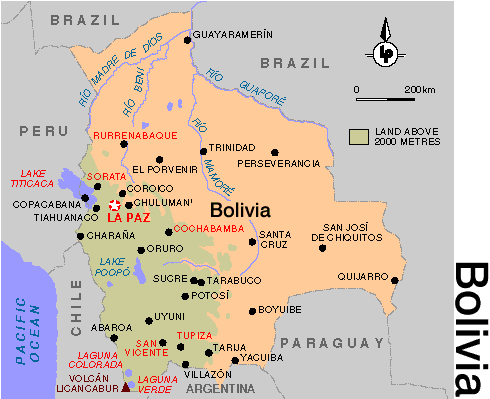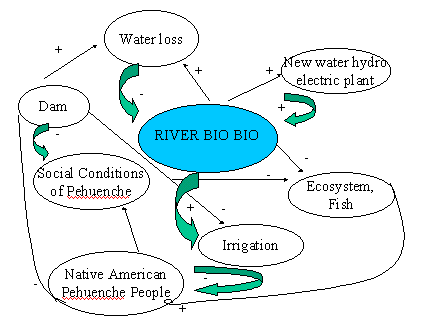
Case Number: 48
Case Identifier: Chaco
Case Name: Chaco War

 I. Case Background
I. Case Background Hostile incidents between Bolivia and Paraguay began in the late 1920's over the Chaco Boreal. Since both countries are landlocked, access to a waterway that would lead to the ocean was vital for commerce and economic success. Paraguay, controlling the Chaco region and its waterways, had much better access to the Atlantic Ocean (through Argentina) than did Bolivia to the north. In 1883 in the War of the Pacific, Bolivia lost its entire coastline to Chile, leaving it severely isolated from its neighbors and the world. This factor was compounded with the notion that the Chaco Boreal was supposedly rich in oil reserves. International oil companies, such as Standard Oil from the U.K., already exploring the southern half of Bolivia, actively sought exploration of the Chaco region lying within Paraguay's borders. Bolivian politicians, at the urgence and demand from these international companies,as well as their need for a waterway, declared war in 1932 and ordered the first shots fired at a Paraguayan border town called Vangaurdia.
Bolivian culture and ethnicity are crucial to understanding the Chaco War and its outcome. In the center of Bolivia lies the Altiplano, a valley between the Andean mountain chains lying approximately 13,000 feet above sea level. The harsh climate and severe topography surrounding this region make the center of this country quite inaccessible to other lower lying regions within Bolivia. The most populated regions of the country are located here.The racial make up of Bolivia is predominately Indian, with ancestry dating back to the Incas. After independence, Indians, the most populous ethnic group, were forced into manual labor positions and servitude to caudillos like in many other Latin American nations. A feeling of national unity based upon boundaries and the nation state system was not innate for most Bolivians. At the time of the Chaco War, most Bolivians had little if any interest in the Chaco region, which lied so far from the economic and political heart of the country. For this reason, Bolivians were apathetic to the war in the Chaco region. Nevertheless, political leaders forced many Indians and indigeneous people into military servitude to fight for the Chaco.
 In the years preceding 1932, minor armed confrontations were frequent along the Bolivian/Paraguayan
border. As war became inevitable in the early months of 1932, Paraguay began mounting huge numbers of troops along its border. As Paraguay was
attempting to adequately arm itself, a Bolivian force stromed the Paraguayan fort at Vangaurdia on
June 15, 1932 and the war began. Both sides had a large stake in the outcome of the war. For Paragauy,
control over the River Paraguay and the Chaco region would ensure the continued production of mate
and the export of this crop so vital to the Paraguayan economy.
In the years preceding 1932, minor armed confrontations were frequent along the Bolivian/Paraguayan
border. As war became inevitable in the early months of 1932, Paraguay began mounting huge numbers of troops along its border. As Paraguay was
attempting to adequately arm itself, a Bolivian force stromed the Paraguayan fort at Vangaurdia on
June 15, 1932 and the war began. Both sides had a large stake in the outcome of the war. For Paragauy,
control over the River Paraguay and the Chaco region would ensure the continued production of mate
and the export of this crop so vital to the Paraguayan economy. For Bolivia, the acquisition of the Chaco
region would result in a waterway neccessary for trade and a potential oil exploration site.
For Bolivia, the acquisition of the Chaco
region would result in a waterway neccessary for trade and a potential oil exploration site.
The war continued for three years. During this time, Bolivia continued to force Indians into military servitude, while foreign oil companies in the country were accused by Paraguay to be financing the Bolivian army.The Paraguayan president, Eusebio Ayala, entrusted General Jose Felix Estigarribia with military decisions. During this time, thousands of soldiers died in the isolated regions of the Chaco. It was difficult for soldiers to survive the harsh climate of the Chaco region. The forrested areas were especially dense, causing many to loose their lives to unknown diseases and infections. More soldiers eventually died from diseases such as malaria than they did from gun shot wounds. Three years into the conflict, and after 100,000 lives were lost, both Paraguay and Bolivia began to feel the harsh economic strains of the war.The Paraguayan army was eventually able push the Bolivians back until they were almost entirely ejected from the Chaco region.
Through foreign mediation, a cease-fire was attained on June 12, 1935. It was confirmed with a truce signed in 1935 by both countires and subsequently by a signed in 1938, awarding Paraguay permanent control of three-quarters of the Chaco Boreal. Bolivia was left defeated, without the waterway it had hoped to attain. Years later, oil companies explored the Chaco region and were unable to find significant deposites of oil. Today, Guarani Indians remain in the Chaco region, along with significant groups of Menonite settlers. Bolivia and Paraguay are no longer on hostile terms and the Chaco Boreal has continued to be used for agricultural purposes by Paraguay.

 II. Environment Aspects
II. Environment Aspects

 III. Conflict Aspects
III. Conflict Aspects 
 IV. Environment and Conflict Overlap
IV. Environment and Conflict Overlap

 V. Related Information and Sources
V. Related Information and Sources Garner, William. The Chaco Dispute: A Study of Prestige Diplomacy. Public Affairs Press, Washington, DC:1966.
Introduction to the Chaco War
This site provides a basic introductory to the Chaco War, highlighting important figures in the dispute.
Book Review of The Chaco War
This site provides a detailed book review of The Chaco War, one of the only English language materials published about this conflict.
Bolivian Indians
The site provides extensive information about the Indians of Bolivia.
Bolivia
Bolivian history is examined in detail.
Paraguay
A brief on-line history of Paraguay and its people.
Bolivia y su historia
Information about the history of Bolivia and its people (in Spanish).
Paraguay y su historia
Information about Paraguay and its history, including the Chaco War (in Spanish).
